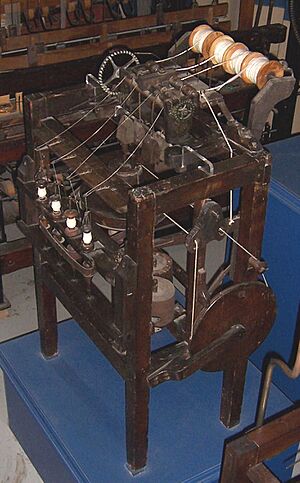John Kay (spinning frame) facts for kids
John Kay was an English inventor who helped create the spinning frame in 1767. This invention was a big step forward for making cloth during the Industrial Revolution. John Kay was born in Warrington, England. He helped build the first spinning frame and said he invented it. Sometimes, people confuse him with another inventor named John Kay from Bury, Lancashire. That other John Kay invented the flying shuttle, a machine for weaving, about 30 years earlier.
Working with Thomas Highs
In 1763, John Kay worked as a clockmaker in Leigh. His neighbor, Thomas Highs, was also an inventor. They worked together to explore new machines for making textiles, which are fabrics like cloth. This included trying to spin thread using rollers.
At that time, weaving cloth was already done by machines. But spinning thread was still mostly done by hand. Another inventor, Lewis Paul, had made a machine with rollers in 1738. However, his machine was not successful in business.
John Kay and Richard Arkwright
In 1767, Kay started working with Richard Arkwright, who was a businessman. Their work together, and who really invented what, later caused many legal fights.
Arkwright first hired Kay to make brass wheels. Arkwright said they were for a machine that could run forever. About six months later, Arkwright hired Kay to build a spinning machine that used rollers.
In 1768, Arkwright took Kay to Preston to make a better version of the machine. Kay had promised to work for Arkwright for 21 years and keep their inventions secret. To avoid attention, Arkwright told people they were working on a machine to find longitude (a way to know your exact location). Even so, the secrecy and the sounds from their workshop made some people think they were doing witchcraft.
Arkwright and Kay later moved to Nottingham. There, in 1769, they built a spinning machine using their ideas. Arkwright got a patent for it in 1769 but did not mention Kay, who was his "workman." Kay found out about this patent from another inventor, James Hargreaves. Kay told Hargreaves that he, Kay, was the real inventor. Arkwright then accused Kay of telling Hargreaves about the design. This caused them to argue, and Kay left Arkwright's house. Kay later said Arkwright stole his tools, and Arkwright made a similar claim against Kay.
The spinning machine built in Nottingham by Kay and Arkwright was powered by horses. It seems it was not very good for business. But it did show that the new machine, called a "spinning frame," could work. This allowed Arkwright to get money to build a bigger mill using water power. This mill was built in 1771 on the River Derwent at Cromford. The new machine, called a "water frame," would change the way textiles were made. It made Arkwright and his partners very rich, but not John Kay.
Patent Disputes
Arkwright got a "Grand Patent" in 1775. This patent covered the spinning frame and other inventions. Later, other mill owners copied his ideas without permission. Arkwright then took them to court to protect his rights. A series of trials began in 1781. In the last trial, in 1785, Arkwright's claims as an inventor were questioned. Highs, Kay, and Kay's wife Sarah all said in court that Arkwright had stolen Highs' invention of the rollers "through Mr. Kay."
After this, different people claimed different things. Some said Arkwright had thought of the design before meeting Kay. Others said Kay had stolen Highs' ideas. Still others said Kay both thought of the machine and built it.
The court case did not fully decide who invented what. However, it was important because it helped make patent law clearer. The judge told the jury they must cancel the patent if the invention was not new enough. They also had to cancel it if Arkwright had not clearly explained the technology in the patent papers. Based on these reasons, the jury canceled the patents. This was a loss for Arkwright, and also for Highs and Kay.


